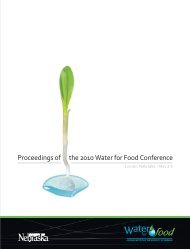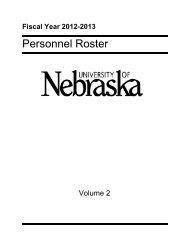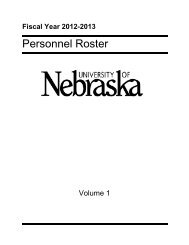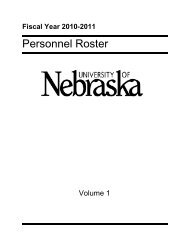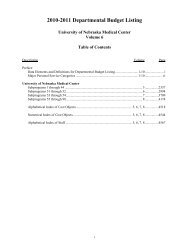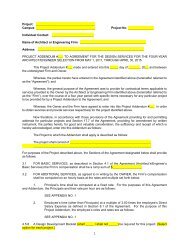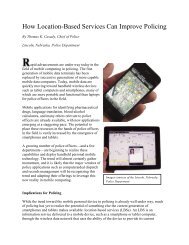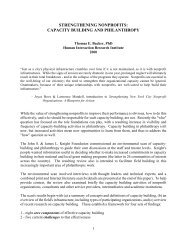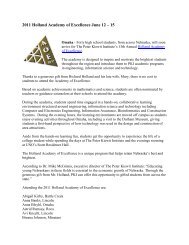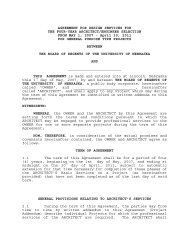Full Version - The Water for Food Institute - University of Nebraska
Full Version - The Water for Food Institute - University of Nebraska
Full Version - The Water for Food Institute - University of Nebraska
You also want an ePaper? Increase the reach of your titles
YUMPU automatically turns print PDFs into web optimized ePapers that Google loves.
He cited the U.S., where the number <strong>of</strong> farmers<br />
has dropped from tens <strong>of</strong> millions in the 1930s<br />
to a few million several decades later, and then to<br />
less than 1 million today.<br />
“It’s our belief at the Gates Foundation that what<br />
ultimately happens is that the improvement in<br />
agricultural productivity creates greater wealth<br />
within the economy and creates greater opportunity<br />
to add value in other industries. But that requires<br />
very careful planning and very careful thinking<br />
through <strong>of</strong> policy.”<br />
Biswas said in India, agricultural technology<br />
was introduced to produce more food <strong>for</strong> a<br />
growing population, but only farmers already<br />
producing marketable crops invested in it.<br />
<strong>The</strong> result was that poorer farmers had even less<br />
market power. PRADAN advocates <strong>for</strong> these<br />
farmers with the Indian government and asks<br />
farmers what technology they need to ensure<br />
that marginal households can produce their<br />
own food, Biswas said.<br />
Similarly, Ayele said, by working with smallholder<br />
farmers, IDE gives them an opportunity<br />
to increase their productivity and their incomes.<br />
“We are making the rural life more attractive<br />
to them and creating a means <strong>of</strong> survival <strong>for</strong><br />
them.” He cited an example in Rift Valley,<br />
Ethiopia. Though the area has many lakes,<br />
farmers traditionally have been unable to af<strong>for</strong>d<br />
irrigation pumps. Commercial farmers come<br />
in, rent the land, irrigate the crops and hire<br />
Proceedings <strong>of</strong> the 2011 <strong>Water</strong> <strong>for</strong> <strong>Food</strong> Conference 43<br />
“e importance <strong>of</strong> prosperity and wealth creation is<br />
key as a mechanism to address poverty.”<br />
landowners as laborers. By <strong>of</strong>fering smallholder<br />
farmers af<strong>for</strong>dable irrigation technology, IDE<br />
gives them an opportunity to work and control<br />
their own land.<br />
Ayele emphasized the need to relate to farmers<br />
as customers. “If they get the opportunity, the<br />
right opportunity, they can lift themselves out<br />
<strong>of</strong> poverty very quickly. That’s what we<br />
have learned.”<br />
Raikes said prosperity, wealth creation and<br />
af<strong>for</strong>dable technology are critical when<br />
addressing poverty. And technology should<br />
not be developed just <strong>for</strong> wealthy farmers.<br />
“We need to think about how we can have more<br />
af<strong>for</strong>dable solutions <strong>for</strong> these smallholder farms.<br />
We need to understand how these farmers can<br />
have market access,” he said.



